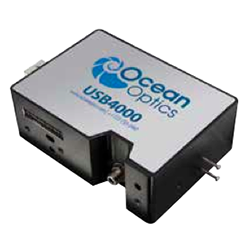In an industry that is currently driven by efficiency and optimum performance, spectroscopy has perhaps never been such a critical factor in the evolution of PV technology. We take a closer look…
With their modest cost, compact size and great flexibility, miniature fibre optic spectrometers are attractive options for the evaluation of materials and equipment used in the testing and production of photovoltaic panels. Typical applications include analysis of the optical properties of solar cell materials, spectroradiometric measurement of solar simulators used in panel testing and quality control in panel production.
Background
Optical sensing tools such as miniature spectrometers (Figure 1) and thin film analyzers have been used in the solar industry for as long as the study of solar materials has existed. The optical properties of such materials are intimately related to their effectiveness for use in PV panels and solar materials.
For example, there are many types of cell materials either being developed or refined, including cadmium telluride, copper indium gallium selenide, dye-sensitised solar cells (fluorine-doped titanium dioxide, with responsiveness in the red and IR regions), organic solar cells (indium tin oxide) and thin-film silicon. In the research lab, spectroscopy in the UV, Visible and near-infrared (NIR) regions can be utilised to determine cell properties such as absorbance, transmission and reflectance.
Quality control testing of PV panels is another scenario where spectroscopic instrumentation can be effective. Reflectometers measure reflection of panel coatings, as well as the thickness of panel layers. In addition, systems can be configured for testing outside the confines of the laboratory or factory floor.
That quality control is a logical application for optical sensing technologies is no surprise. Solar industries are constantly looking for ways to better manage their supply chain, reduce waste and off-specification product and increase yields in manufacturing, and build value in the brand of their products.
Small savings or improvements can drive the difference between being successful and merely surviving. Success can be achieved with instrumentation that is rugged, reliable and built around solutions that help drive operating decisions.



























